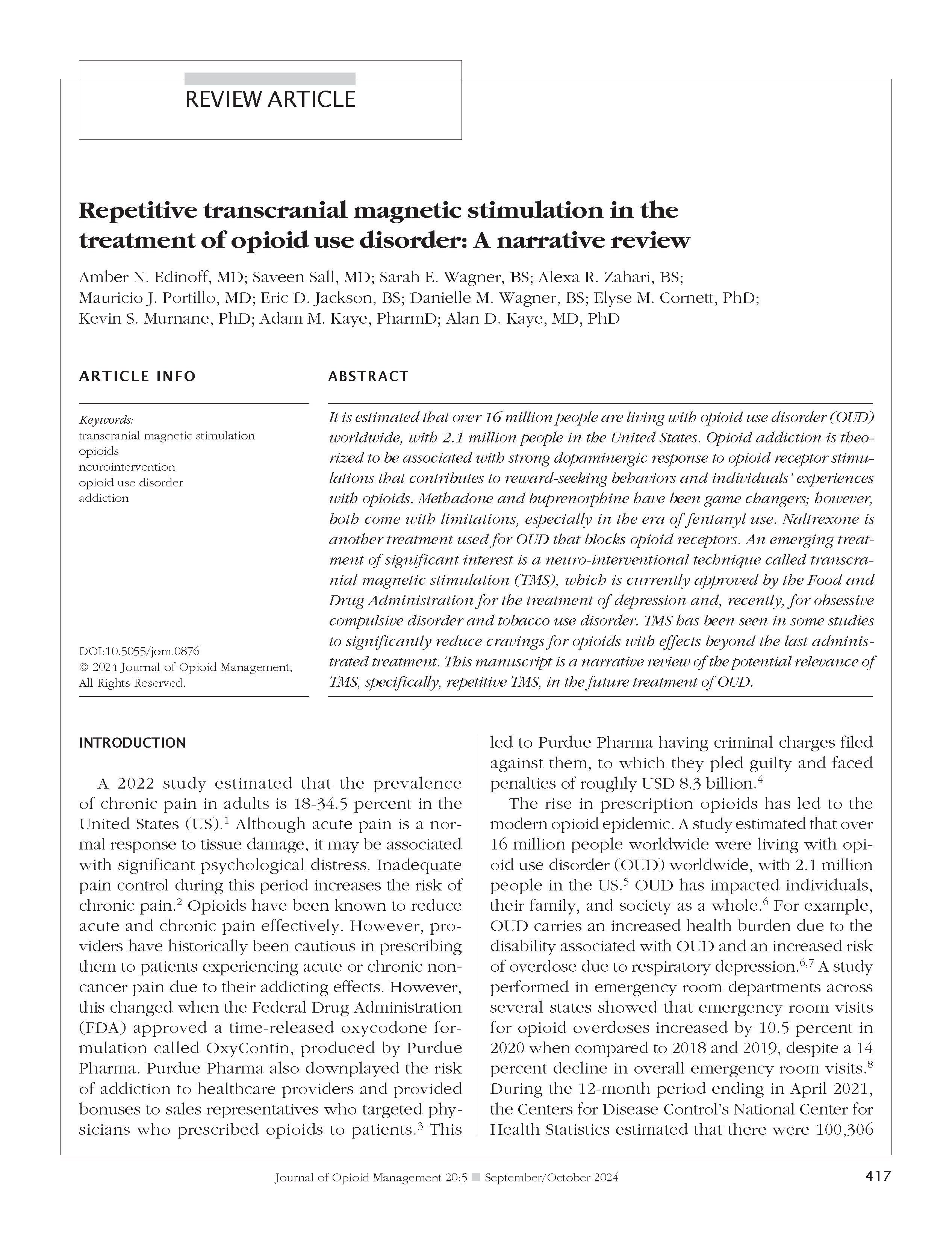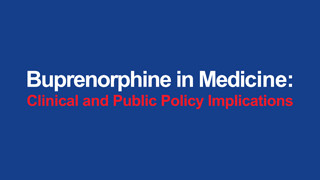Repetitive transcranial magnetic stimulation in the treatment of opioid use disorder: A narrative review
DOI:
https://doi.org/10.5055/jom.0876Keywords:
transcranial magnetic stimulation, opioids, neurointervention, opioid use disorder, addictionAbstract
It is estimated that over 16 million people are living with opioid use disorder (OUD) worldwide, with 2.1 million people in the United States. Opioid addiction is theorized to be associated with strong dopaminergic response to opioid receptor stimulations that contributes to reward-seeking behaviors and individuals' experiences with opioids. Methadone and buprenorphine have been game changers; however, both come with limitations, especially in the era of fentanyl use. Naltrexone is another treatment used for OUD that blocks opioid receptors. An emerging treatment of significant interest is a neuro-interventional technique called transcranial magnetic stimulation (TMS), which is currently approved by the Food and Drug Administration for the treatment of depression and, recently, for obsessive compulsive disorder and tobacco use disorder. TMS has been seen in some studies to significantly reduce cravings for opioids with effects beyond the last administrated treatment. This manuscript is a narrative review of the potential relevance of TMS, specifically, repetitive TMS, in the future treatment of OUD.
References
Yong RJ, Mullins PM, Bhattacharyya N: Prevalence of chronic pain among adults in the United States. Pain. 2022; 163(2): e328-e332. DOI: https://doi.org/10.1097/j.pain.0000000000002291
Anwar K: Pathophysiology of pain. Dis Mon. 2016; 62(9): 324-329. DOI: https://doi.org/10.1016/j.disamonth.2016.05.015
Van Zee A: The promotion and marketing of oxycontin: Commercial triumph, public health tragedy. Am J Public Health. 2009; 99(2): 221-227. DOI: https://doi.org/10.2105/AJPH.2007.131714
Hoffman J, Benner K: Purdue pharma pleads guilty to criminal charges for opioid sales. The New York Times. October 21, 2020. Available at https://www.nytimes.com/2020/10/21/health/purdue-opioids-criminal-charges.html. Accessed September 9, 2022.
Dydyk AM, Jain NK, Gupta M: Opioid use disorder. StatPearls. StatPearls Publishing. 2022. Available at https://www.ncbi.nlm.nih.gov/books/NBK553166/. Accessed September 9, 2022.
Strang J, Volkow ND, Degenhardt L, et al.: Opioid use disorder. Nat Rev Dis Primers. 2020; 6(1): 3. DOI: https://doi.org/10.1038/s41572-019-0137-5
Vos T, Abajobir AA, Abate KH, et al.: Global, regional, and national incidence, prevalence, and years lived with disability for 328 diseases and injuries for 195 countries, 1990–2016: A systematic analysis for the global burden of disease study 2016. Lancet. 2017; 390(10100): 1211-1259. DOI: https://doi.org/10.1016/S0140-6736(17)32154-2
Soares WE, Melnick ER, Nath B, et al.: Emergency department visits for nonfatal opioid overdose during the COVID-19 pandemic across six US health care systems. Ann Emerg Med. 2022; 79(2): 158-167. DOI: https://doi.org/10.1016/j.annemergmed.2021.03.013
CDC: Drug overdose deaths in the US top 100,000 annually. 2021. Available at https://www.cdc.gov/nchs/pressroom/nchs_press_releases/2021/20211117.htm. Accessed September 11, 2022.
Wang SC, Chen YC, Lee CH, et al.: Opioid addiction, genetic susceptibility, and medical treatments: A review. Int J Mol Sci. 2019; 20(17): 4294. DOI: https://doi.org/10.3390/ijms20174294
Blackwood CA, Cadet JL: The molecular neurobiology and neuropathology of opioid use disorder. Curr Res Neurobiol. 2021; 2: 100023. DOI: https://doi.org/10.1016/j.crneur.2021.100023
Berridge KC, Robinson TE: Liking, wanting, and the incentive- sensitization theory of addiction. Am Psychol. 2016; 71(8): 670-679. DOI: https://doi.org/10.1037/amp0000059
Land BB, Bruchas MR, Lemos JC, et al.: The dysphoric component of stress is encoded by activation of the dynorphin kappa-opioid system. J Neurosci. 2008; 28(2): 407-414. DOI: https://doi.org/10.1523/JNEUROSCI.4458-07.2008
Schlosburg JE, Whitfield TW, Park PE, et al.: Long-term antagonism of κ opioid receptors prevents escalation of and increased motivation for heroin intake. J Neurosci. 2013; 33(49): 19384-19392. DOI: https://doi.org/10.1523/JNEUROSCI.1979-13.2013
Robinson TE, Berridge KC: The neural basis of drug craving: An incentive-sensitization theory of addiction. Brain Res Brain Res Rev. 1993; 18(3): 247-291. DOI: https://doi.org/10.1016/0165-0173(93)90013-P
Lueptow LM, Shashkova EC, Miller MG, et al.: Insights into the neurobiology of craving in opioid use disorder. Curr Anesthesiol Rep. 2020; 10(4): 378-387. DOI: https://doi.org/10.1007/s40140-020-00420-7
Kampman K, Jarvis M: American Society of Addiction Medicine (ASAM) national practice guideline for the use of medications in the treatment of addiction involving opioid use. J Addict Med. 2015; 9(5): 358-367. DOI: https://doi.org/10.1097/ADM.0000000000000166
Koehl JL, Zimmerman DE, Bridgeman PJ: Medications for management of opioid use disorder. Am J Health Syst Pharm. 2019; 76(15): 1097-1103. DOI: https://doi.org/10.1093/ajhp/zxz105
Lugo RA, Satterfield KL, Kern SE: Pharmacokinetics of methadone. J Pain Palliat Care Pharmacother. 2005; 19(4): 13-24. DOI: https://doi.org/10.1300/J354v19n04_05
Faggiano F, Vigna-Taglianti F, Versino E, et al.: Methadone maintenance at different dosages for opioid dependence. Cochrane Database Syst Rev. 2003; (3): CD002208. DOI: https://doi.org/10.1002/14651858.CD002208
Fredheim OMS, Moksnes K, Borchgrevink PC, et al.: Clinical pharmacology of methadone for pain. Acta Anaesthesiol Scand. 2008; 52(7): 879-889. DOI: https://doi.org/10.1111/j.1399-6576.2008.01597.x
Kuhlman JJ, Lalani S, Magluilo J, et al.: Human pharmacokinetics of intravenous, sublingual, and buccal buprenorphine. J Anal Toxicol. 1996; 20(6): 369-378. DOI: https://doi.org/10.1093/jat/20.6.369
Lewis JW: Buprenorphine. Drug Alcohol Depend. 1985; 14(3–4): 363-372. DOI: https://doi.org/10.1016/0376-8716(85)90067-5
Buresh M, Stern R, Rastegar D: Treatment of opioid use disorder in primary care. BMJ. 2021; 373: n784. DOI: https://doi.org/10.1136/bmj.n784
Coe MA, Lofwall MR, Walsh SL: Buprenorphine pharmacology review: Update on transmucosal and long-acting formulations. J Addict Med. 2019; 13(2): 93-103. DOI: https://doi.org/10.1097/ADM.0000000000000457
Antoine D, Huhn AS, Strain EC, et al.: Method for successfully inducting individuals who use illicit fentanyl onto buprenorphine/naloxone. Am J Addict. 2021; 30(1): 83-87. DOI: https://doi.org/10.1111/ajad.13069
Jasinski DR, Pevnick JS, Griffith JD: Human pharmacology and abuse potential of the analgesic buprenorphine: A potential agent for treating narcotic addiction. Arch Gen Psychiatry. 1978; 35(4): 501-516. DOI: https://doi.org/10.1001/archpsyc.1978.01770280111012
Fiellin DA, Schottenfeld RS, Cutter CJ, et al.: Primary care-based buprenorphine taper vs maintenance therapy for prescription opioid dependence: A randomized clinical trial. JAMA Intern Med. 2014; 174(12): 1947-1954. DOI: https://doi.org/10.1001/jamainternmed.2014.5302
Weinstein ZM, Kim HW, Cheng DM, et al.: Long-term retention in office based opioid treatment with buprenorphine. J Subst Abuse Treat. 2017; 74: 65-70. DOI: https://doi.org/10.1016/j.jsat.2016.12.010
Gibson AE, Doran CM, Bell JR, et al.: A comparison of buprenorphine treatment in clinic and primary care settings: A randomised trial. Med J Aust. 2003; 179(1): 38-42. DOI: https://doi.org/10.5694/j.1326-5377.2003.tb05417.x
Fiellin DA, Moore BA, Sullivan LE, et al.: Long-term treatment with buprenorphine/naloxone in primary care: Results at 2-5 years. Am J Addict. 2008; 17(2): 116-120. DOI: https://doi.org/10.1080/10550490701860971
Edinoff AN, Nix CA, Orellana CV, et al.: Naltrexone implant for opioid use disorder. Neurol Int. 2021; 14(1): 49-61. DOI: https://doi.org/10.3390/neurolint14010004
Providers Clinical Support System: Methadone then and now. Available at https://pcssnow.org/wp-content/uploads/2021/07/Methadone-Then-and-Now.pdf. Accessed September 11, 2022.
CTC: Mentioring, education, and clinical tools for addiction. Methadone treatment for people who use fentanyl: Recommendations. Available at https://comprehensivetreatmentclinic.com/assets/images/static/backend/uploads/MethadoneForFentanyl.pdf. Accessed September 11, 2022.
Iglesias AH: Transcranial magnetic stimulation as treatment in multiple neurologic conditions. Curr Neurol Neurosci Rep. 2020; 20: 1. DOI: 10.1007/s11910-020-1021-0. DOI: https://doi.org/10.1007/s11910-020-1021-0
Burke MJ, Fried PJ, Pascual-Leone A: Chapter 5—Transcranial magnetic stimulation: Neurophysiological and clinical applications. In D'Esposito M, Grafman JH (eds.): Handbook of Clinical Neurology. Amsterdam: Elsevier, 2019: 73-92. The Frontal Lobes; vol. 163. Available at https://www.sciencedirect.com/science/article/pii/B9780128042816000057. Accessed September 20, 2022. DOI: https://doi.org/10.1016/B978-0-12-804281-6.00005-7
Department of Psychiatry: How does TMS work? Available at https://www.med.unc.edu/psych/patient-care/interventionalpsychiatry/tms/how-tms-works/. Accessed September 20, 2022.
Chervyakov AV, Chernyavsky AY, Sinitsyn DO, et al.: Possible mechanisms underlying the therapeutic effects of transcranial magnetic stimulation. Front Hum Neurosci. 2015; 9: 303. DOI: https://doi.org/10.3389/fnhum.2015.00303
Sugel J, Stairway Resource Center Inc.: Transcranial magnetic stimulation (TMS) in substance abuse treatment. 2024. Available at https://stairwayrecovery.com/blog/transcranialmagnetic-stimulation-tms-in-substance-abuse-treatment/. Accessed September 21, 2022.
Gorelick DA, Zangen A, George MS: Transcranial magnetic stimulation (TMS) in the treatment of substance addiction. Ann N Y Acad Sci. 2014; 1327(1): 79-93. DOI: https://doi.org/10.1111/nyas.12479
Edinoff AN, Sall S, Roberts TD, et al.: Transcranial stimulation for the treatment of stimulant use disorder. Neurol Int. 2023; 15(1): 325-338. DOI: https://doi.org/10.3390/neurolint15010021
Ceccanti M, Inghilleri M, Attilia ML, et al.: Deep TMS on alcoholics: Effects on cortisolemia and dopamine pathway modulation. A pilot study. Can J Physiol Pharmacol. 2015; 93(4): 283-290. DOI: https://doi.org/10.1139/cjpp-2014-0188
Park P: Transcranial magnetic stimulation device cleared for smoking cessation. MPR. 2020. Available at https://www.empr.com/home/news/smoking-cessation-deep-transcranialmegnetic-stimulation-tns-brainsway/. Accessed September 21, 2022.
Trojak B, Meille V, Achab S, et al.: Transcranial magnetic stimulation combined with nicotine replacement therapy for smoking cessation: A randomized controlled trial. Brain Stimul. 2015; 8(6): 1168-1174. DOI: https://doi.org/10.1016/j.brs.2015.06.004
Shen Y, Cao X, Tan T, et al.: 10-Hz repetitive transcranial magnetic stimulation of the left dorsolateral prefrontal cortex reduces heroin cue craving in long-term addicts. Biol Psychiatry. 2016; 80(3): e13-e14. DOI: https://doi.org/10.1016/j.biopsych.2016.02.006
Liu X, Zhao X, Liu T, et al.: The effects of repetitive transcranial magnetic stimulation on cue-induced craving in male patients with heroin use disorder. EBioMedicine. 2020; 56: 102809. DOI: https://doi.org/10.1016/j.ebiom.2020.102809
Li X, Song GF, Yu JN, et al.: Effectiveness and safety of repetitive transcranial magnetic stimulation for the treatment of morphine dependence: A retrospective study. Medicine (Baltimore). 2021; 100(14): e25208. DOI: https://doi.org/10.1097/MD.0000000000025208
Tsai TY, Wang TY, Liu YC, et al.: Add-on repetitive transcranial magnetic stimulation in patients with opioid use disorder undergoing methadone maintenance therapy. Am J Drug Alcohol Abuse. 2021; 47(3): 330-343. DOI: https://doi.org/10.1080/00952990.2020.1849247
Imperatore JP, McCalley DM, Borckardt JJ, et al.: Noninvasive brain stimulation as a tool to decrease chronic pain in current opiate users: A parametric evaluation of two promising cortical targets. Drug Alcohol Depend. 2021; 218: 108409. DOI: https://doi.org/10.1016/j.drugalcdep.2020.108409

Published
How to Cite
Issue
Section
License
Copyright 2005-2025, Weston Medical Publishing, LLC and Journal of Opioid Management. All Rights Reserved.










